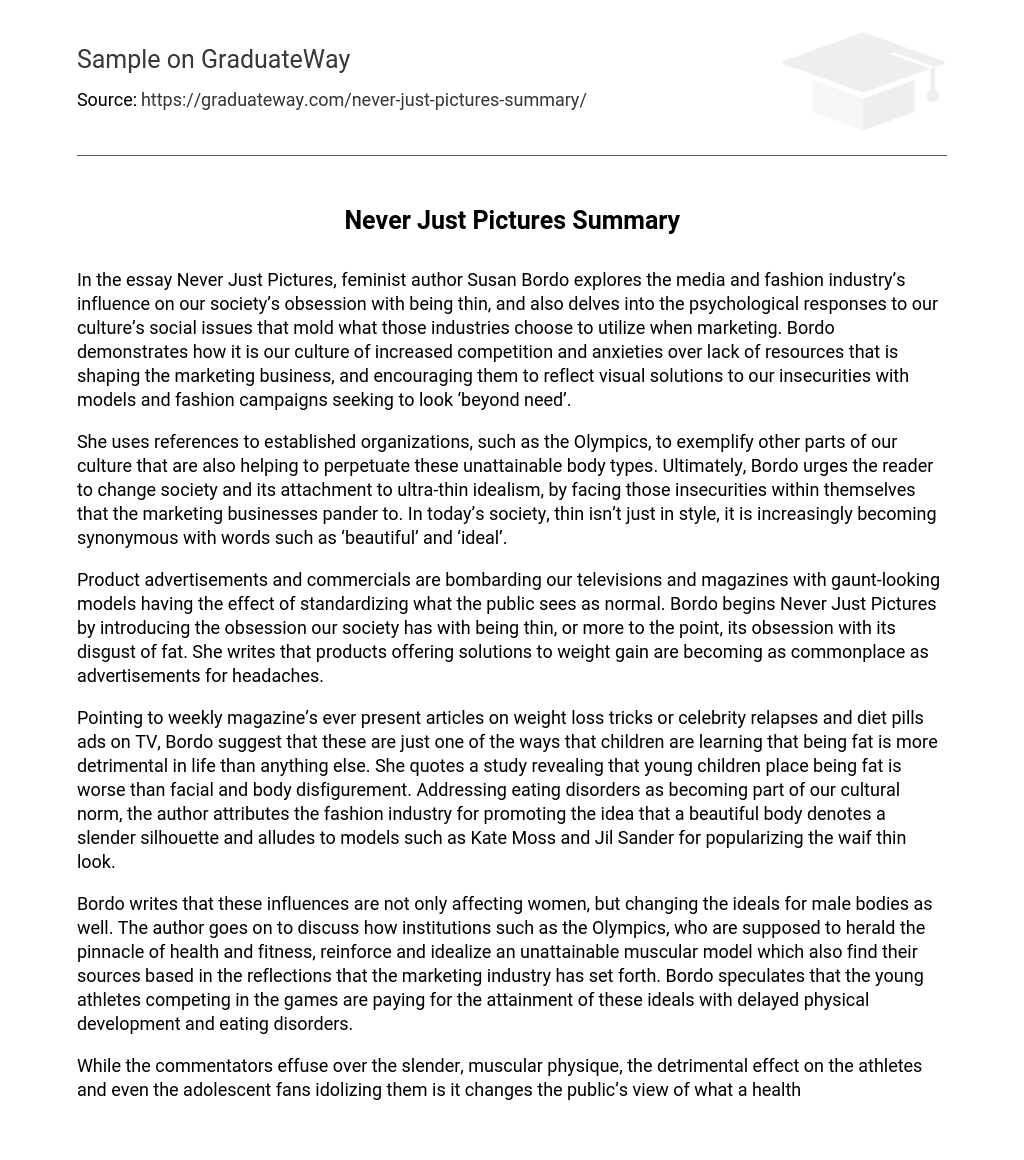In the essay Never Just Pictures, feminist author Susan Bordo explores the media and fashion industry’s influence on our society’s obsession with being thin, and also delves into the psychological responses to our culture’s social issues that mold what those industries choose to utilize when marketing. Bordo demonstrates how it is our culture of increased competition and anxieties over lack of resources that is shaping the marketing business, and encouraging them to reflect visual solutions to our insecurities with models and fashion campaigns seeking to look ‘beyond need’.
She uses references to established organizations, such as the Olympics, to exemplify other parts of our culture that are also helping to perpetuate these unattainable body types. Ultimately, Bordo urges the reader to change society and its attachment to ultra-thin idealism, by facing those insecurities within themselves that the marketing businesses pander to. In today’s society, thin isn’t just in style, it is increasingly becoming synonymous with words such as ‘beautiful’ and ‘ideal’.
Product advertisements and commercials are bombarding our televisions and magazines with gaunt-looking models having the effect of standardizing what the public sees as normal. Bordo begins Never Just Pictures by introducing the obsession our society has with being thin, or more to the point, its obsession with its disgust of fat. She writes that products offering solutions to weight gain are becoming as commonplace as advertisements for headaches.
Pointing to weekly magazine’s ever present articles on weight loss tricks or celebrity relapses and diet pills ads on TV, Bordo suggest that these are just one of the ways that children are learning that being fat is more detrimental in life than anything else. She quotes a study revealing that young children place being fat is worse than facial and body disfigurement. Addressing eating disorders as becoming part of our cultural norm, the author attributes the fashion industry for promoting the idea that a beautiful body denotes a slender silhouette and alludes to models such as Kate Moss and Jil Sander for popularizing the waif thin look.
Bordo writes that these influences are not only affecting women, but changing the ideals for male bodies as well. The author goes on to discuss how institutions such as the Olympics, who are supposed to herald the pinnacle of health and fitness, reinforce and idealize an unattainable muscular model which also find their sources based in the reflections that the marketing industry has set forth. Bordo speculates that the young athletes competing in the games are paying for the attainment of these ideals with delayed physical development and eating disorders.
While the commentators effuse over the slender, muscular physique, the detrimental effect on the athletes and even the adolescent fans idolizing them is it changes the public’s view of what a healthy body looks like. With the power of the media to create the image what is beautiful and normal to signify ultra-thin body types, Bordo discusses rampant spread of eating disorders in our society. She argues that while eating disorders and exercise compulsions are progressively bridging gender and racial gaps, they are merely symptoms of greater societal problem.
General anxieties over the steady increase of the depletion and heightened competition for resources have altered the expectations of how bodies should look. Combined with a consumer culture endorsing wanton -self-indulgence to boost sales, and opposingly, idealizing self-control and deriding weight gain as a sign of laziness, the image of the emaciated model offers an attraction of living beyond want or need. Bordo contends that the media and fashion industries, while responsible for the mass imagery of this detrimental archetype, are merely responding to what they see will sell their product.
Bordo calls it the profit motive. Bordo goes on to describe the market struggle between the different product lines’ use of the ideal, pitting clothing and perfume versus makeup. These companies, acutely aware of the ebb and flow of contemporary morals and current limited resources, each encourage consumers to disregard the perfection the other product symbolizes in preference of their own product. However, regardless of the product, each still make use of the thin model.
It’s clear that Bordo’s message in Never Just Pictures is that the idea of beauty and positive body image can be reclaimed from the fashion industry and other institutions when society learns to deal with the insecurities brought about by our feelings of deficiency and inadequacy. Once these issues are carefully reflected on and addressed, the commercial industries will that reflect that change and begin to market with normal body types.
Works Cited:
Bordo, Susan, “Never Just Pictures” from Twilight Zones: The Hidden Life of the Cultural Images from Plato to O. J. , Univ. California 1997





